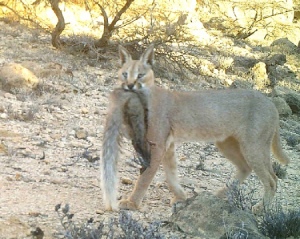The lynx's predatory behavior in the mountains of the Dhofar Governorate has been highlighted in a scientific report by Omani researchers. The report, published by the International Union for Conservation of Nature's Felidae magazine in Switzerland, revealed that the lynx was observed preying on various mammals, including small rodents and rock hyraxes.
Dr. Hadi bin Muslim Al Hakamani, a member of the research team, emphasized that these observations provide valuable insights into the predatory behavior and diet of this medium-sized feline in the Arabian Peninsula.
This report marks the first scientific observation of the lynx hunting the white-tailed mongoose in the region, shedding light on the little-known aspects of the lynx's behavior and diet in the Arabian Peninsula.
Only two studies have been conducted on the lynx so far. One study involved tracking an adult male lynx in the north of the Kingdom of Saudi Arabia in 1998 using a wireless device, while another study in 2006 focused on analyzing lynx dung samples in the United Arab Emirates and the Musandam Peninsula.
The lynx is categorized as "least threatened" globally by the International Union for Conservation of Nature (IUCN), but regional assessments for North Africa, West and Central Asia, including the Arabian Peninsula, indicate that it is at risk of extinction.
In Jordan and the United Arab Emirates, the lynx is considered a rare species, while in Turkey and India, it is locally threatened. In the Sultanate of Oman, the lynx is found in the mountains of the Dhofar Governorate in the south and the Musandam Mountains in the north, but not in sandy areas like the Empty Quarter and the Sharqiyah Sands.
Threats to the lynx vary across its global range. In central, western, and northeastern Africa, habitat change due to agriculture and desertification poses the main threat, while in the Arabian Peninsula, habitat loss due to paved roads and the construction of population centers are the primary concerns.
Studies have shown that the lynx's diet varies depending on its location, with the lynx in northern Saudi Arabia primarily feeding on rodents and occasionally on small camels, eagles, and deer. In the United Arab Emirates, the lynx's diet mainly consists of livestock, such as goats and sheep, along with evidence of the Arabian spiny mouse and unidentified bird species.
Field surveys conducted in the mountains of Dhofar Governorate revealed that the lynx preys on various small mammals, including rodents like the African grass rat, Arabian spiny rat, and golden spiny rat. Additionally, the lynx has been observed hunting the rock hyrax, Arabian partridge, and white-tailed mongoose in the region.
These survey findings offer valuable insights into the lynx's feeding habits and behavior in the Dhofar Governorate mountains and the broader Arabian Peninsula. This information is crucial for environmental organizations looking to safeguard and reintroduce the lynx in the area.









